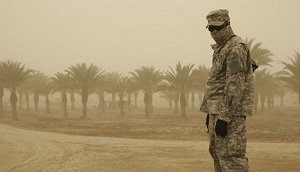Attention A T users. To access the menus on this page please perform the following steps.
1. Please switch auto forms mode to off.
2. Hit enter to expand a main menu option (Health, Benefits, etc).
3. To enter and activate the submenu links, hit the down arrow.
You will now be able to tab or arrow up or down through the submenu options to access/activate the submenu links.
Locator
Contact
Search
Airborne Hazards
 |
|
More Information Providers Learn More |
Many Veterans are concerned about exposure to airborne hazards after deployment to Iraq and Afghanistan. Airborne hazards include particulate matter (PM) and gaseous air pollutants that may originate from the following sources:
- Burning of human and non-human solid wastes
- Smoke from structural fires and explosions
- Smoke from burning oil wells
- Dust and sand particles
- Industrial and ambient air pollution
- Air craft and automobile engine exhaust



















